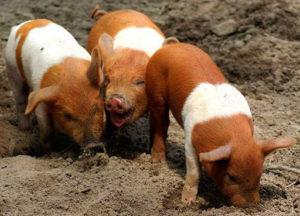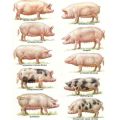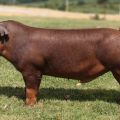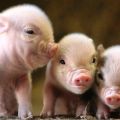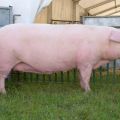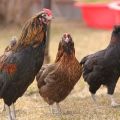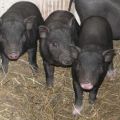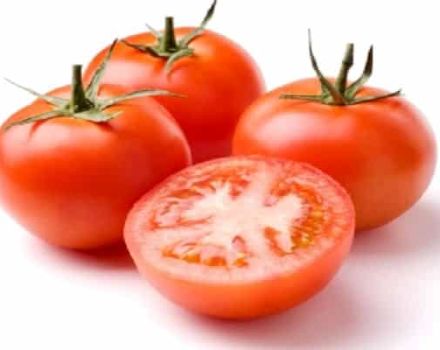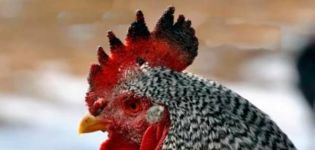Characteristics and description of the Hungarian mangalitsa pig breed, maintenance and breeding
Among the original looking pig breeds, the Hungarian mangalica stands out. Its uniqueness lies in the fact that the animal is covered from head to toe with thick curly hair. The non-standard appearance attracts breeders, the breed is becoming popular and in demand. Although the mangalitsa was bred to obtain lard, today it is increasingly used as an unusual decorative pet.
Origin story
The breed appeared in Hungary in the 19th century as a result of crossing local pigs with wild boars and Serbian Shumadi. The pig turned out to be fast-growing, unpretentious in care. It is believed that the Hungarian mangalica in its characteristics is close to the Lincolnshire English. In 1927, Hungary began to improve the breed. Until the middle of the 20th century, it remained one of the most popular, after which the population began to decline everywhere. Since the end of the 20th century, the cultivation of the Mangalitsky breed has been started in Canada, the USA, and many European countries.
Features and characteristics of the pig mangalitsa
Hungarian down is distinguished by long curly wool, for which piglets are sometimes called sheep-pigs. When living in a warm pigsty and getting enough feed, the need for wool disappears, and pigs can go bald... In more severe natural conditions, by winter the woolen cover is actively growing, becoming thicker. Through it, black stripes are clearly visible on the skin, reminiscent of wild ancestors.
The main standards of the Hungarian mangalitsa breed include:
- straight back line:
- wide chest;
- medium-sized head;
- hooked snout;
- erect ears;
- a voluminous tail with a tassel at the base.
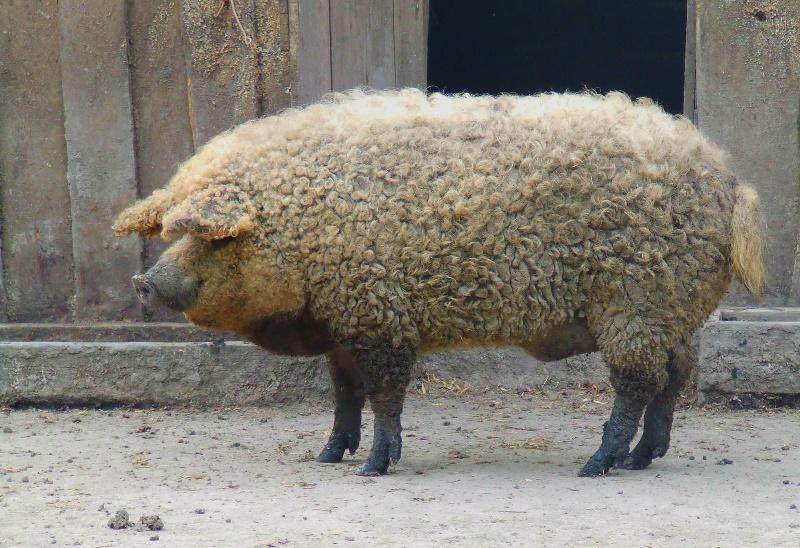
Among the main characteristics of the Hungarian mangalica:
- the average weight of adults is 200 kg for pigs, 300 kg for boars;
- maximum weight of individuals - 500 kg;
- at the age of six months, their weight is 70 kg;
- at the first farrowing, the number of piglets is 4-5, then - about 9;
- farrowed sows of the Hungarian mangalica have a pronounced maternal instinct, they carefully feed the offspring;
- farrowing passes without problems;
- the quality of the meat is above average;
- fat with a thickness of 5 to 10 cm at the age of one;
- high immunity.
Pigs of the Mangalitsa breed are unpretentious in food, they are able to find their own food on a free range. In cold weather, the piglets lie between the furry females, which warm them with their warmth.
Existing varieties
Purebred Hungarian mangalitsa have three types of color (coat color) - white, swallow, red.All of them have a grayish skin tone, and the edging of the eyes, mouth, all hooves, nipples, eyebrows, edges of the nose are black. An ear spot of about 5 cm is a distinctive feature of the breed.
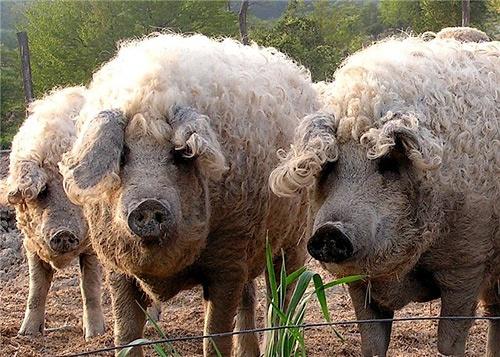
There were more species, but gradually some of them were lost, and restoration is almost impossible.
White mangalitsa
The main part of the total livestock of the breed (about 80%) is the white species of Hungarian mangalits. Pigs are of medium size, with a strong build, strong bones.
White downy can have gray, reddish, yellow wool. It depends on the type and composition of the food and the presence of specific minerals in it.
Red and black mangalitsa
Piglets with red hair are larger than white pigs. This type of Hungarian mangalica breed quickly gains weight and is more productive. The coat is dark red or brown. Thanks to their curly hair, animals can easily tolerate winter temperatures. Initially, the coat is straight, later, at the age of several months, the piglets become curly-shaggy. The meat is considered one of the most delicious, creamy white lard, high in omega-3 fatty acids. The black type of mangalitsa is so rare today that many experts consider it lost.

Swallow
This type of curly pigs is obtained by crossing the white species with the disappeared black one. The result is a combined color - the coat on the sides and back is black, and the underside of the body (belly) is light (grayish or yellowish).
The species is smaller than the white mangalits, although the physique is powerful. The swallow's wool is tough, rough, and can protect against severe frosts and injury.
Pros and cons of the breed
According to the reviews of the breeders, the advantages of the breed include:
- unpretentious maintenance - almost the whole year they can safely be in the pasture, only in winter, fluffy pigs are transferred to the premises;
- low costs for feed - mangalits, being on free grazing, are able to find food for themselves;
- stable immunity - animals rarely get sick, do not require vaccination, use of antibiotics;
- calm disposition - attached to the house and owners;
- stress resistance - they do not need to create special conditions;
- quickly gain weight - within a year they can reach 170 kg;
- high quality meat - an environmentally friendly product has a marble structure, and lard is easily heated.
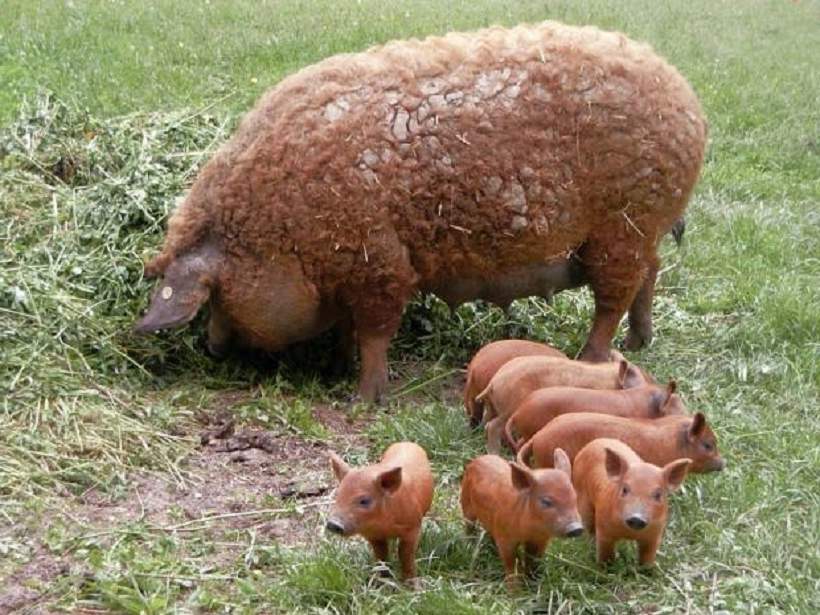
There are not so many disadvantages of the Hungarian mangalitsa breed:
- high cost of breeding material - it is difficult to find it, some species are on the verge of extinction;
- long period of puberty - occurs no earlier than the 7th month of life;
- low fertility - no more than 5 piglets are born at the first farrowing;
- the need for a large area of pastures - to provide food and comply with sanitary standards.
Feeding and care
It is believed that the Hungarian mangalica belongs to the greasy type. Free-range pigs produce meat with fat streaks, creating a marbling effect. It is not recommended to keep woolen pigs in stalls throughout the year, since in this case the percentage of fat increases, the marbling of the product disappears. Semi-free grazing is considered the most favorable for the Hungarian mangalitsa breed. Animals feed on grass, insects, frogs, worms, plant roots. It is necessary to provide free access to clean water. With this method of keeping, the weight grows slowly. To speed up the process, you can additionally feed the pigs with combined grain feed.
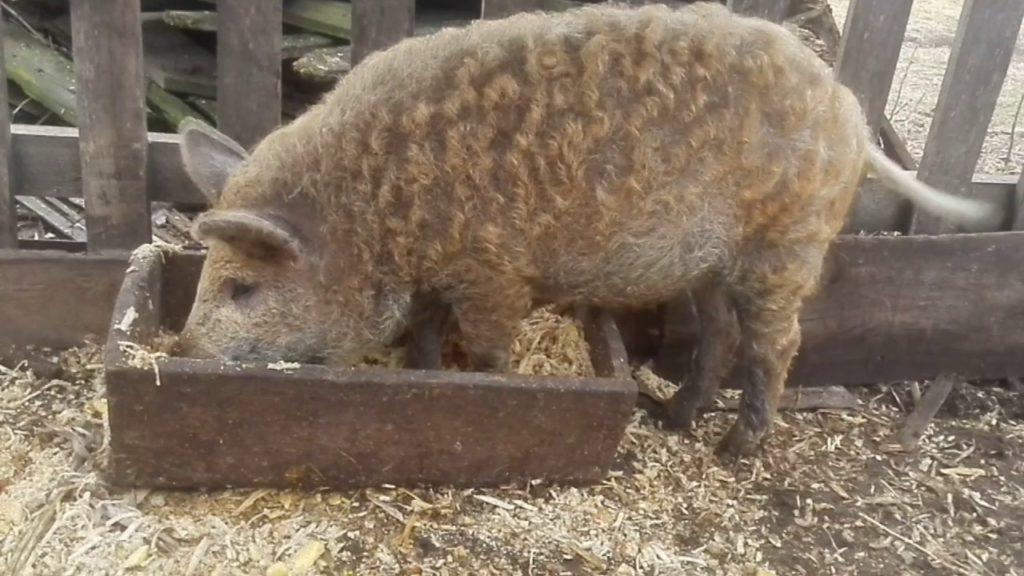
If free grazing of Hungarian mangalits is impossible, their diet should include:
- juicy green food;
- chopped barley;
- wheat;
- bran;
- corn;
- fish meal.
Juicy feeds make up at least 2/3 of the total diet.When fattening on potatoes and grain, the percentage of fat in the resulting product increases significantly, the taste decreases, the marbling disappears. Corn, pumpkin, weeds, algae, bush branches, root crops are used as plant feed. In winter they give hay, acorns, chestnuts.
Observing the diet, it is possible to achieve the formation of interlayers and the growth of the live weight of a piglet of the Hungarian mangalitsa breed up to 500 kg.
Frequent illnesses
The Hungarian mangalica has good health. This is due to the lifestyle and innate immunity of the animal. The breed is resistant to infectious diseases, which is not a reason to refuse prevention. Veterinarians advise not to violate the vaccination schedule, since there is no guarantee against epidemics, especially for free-range individuals.
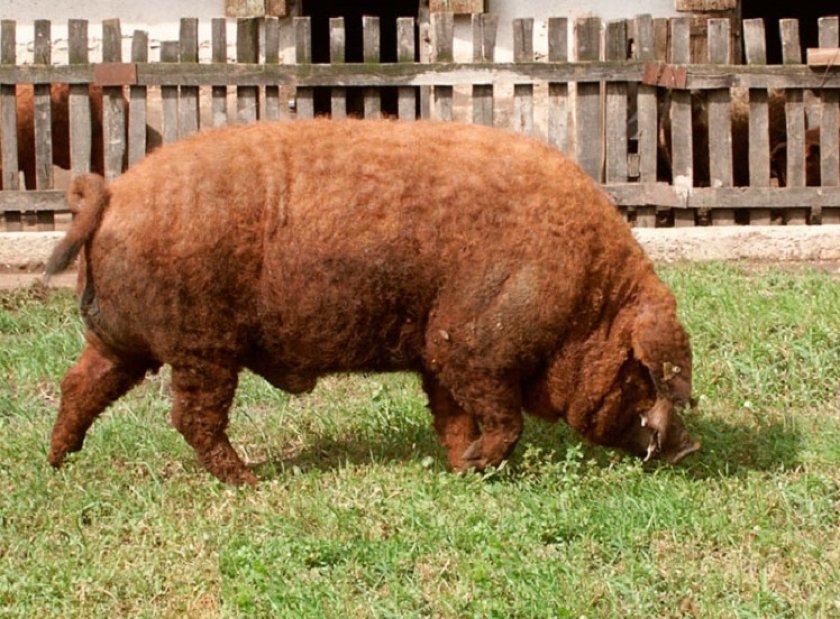
For the Hungarian mangalitsa, as well as for other breeds, treatment measures for skin parasites and helminths are mandatory. Worm infestations are often found in them, infection on free grazing occurs through dirty water of reservoirs, fish, and household waste.
When feeding spoiled food or eating poisonous plants, diseases of the gastrointestinal tract occur - poisoning, gastritis, enteritis, stomach ulcers. Keeping shaggy pigs in rooms with drafts leads to pathologies of the respiratory tract - bronchitis, chronic cough.
When eating large vegetables, fruits, root vegetables, blockage of the esophagus is possible. Foreign bodies - nails, chips, wire - can get into the digestive tract of the Hungarian mangalica. It is necessary to carefully monitor the sanitary maintenance of the premises and walking, the animals themselves, in order to provide assistance in time, if necessary.
Breeding Hungarian mangalits
At the age of 1 year, Hungarian mangalis reach sexual maturity. By this time, they weigh about 100 kg. The gestation time is 110-120 days. Newly born piglets have short hair. At the time of farrowing, the room is equipped with a heat lamp to quickly dry them. The sows are kept indoors with the young, and are fed with mother's milk for up to one and a half months. At the age of 4 days, the fangs are broken off from the piglets so that they do not hurt the uterus during feeding. At 2-3 weeks, boletus intended for growing for meat are castrated. Thanks to the expressed maternal instinct, the sows of the Hungarian mangalica carefully look after and protect the offspring.
At two weeks, piglets begin to feed with bran, barley. They eat rough food a month. A full transition to a normal diet occurs at 4 months. You should buy young Hungarian mangalica for breeding on a farm, where you can see the parents of the purchased pigs.
